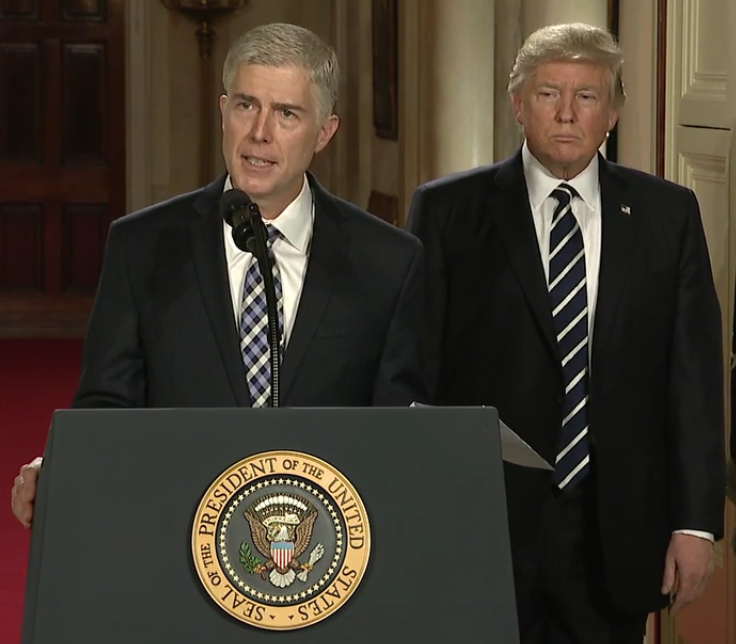Judge Neil Gorsuch: New Supreme Court Justice
Credit: Courtesy of the White House
Grouch’s nomination for the Supreme Court was met with mixed responses.
May 17, 2017
After weeks of controversy and nomination hearings, President Trump’s conservative Supreme Court nominee Neil Gorsuch was confirmed on April 7.
Gorsuch was born in Denver, Colorado in 1967 to Anne Gorsuch Burford and David Gorsuch, both lawyers. He attended primary school in Colorado, but later graduated in 1985 from Georgetown Preparatory School in Maryland.
Gorsuch earned his undergraduate degree in Political Science at Columbia University, graduating Phi Beta Kappa. At Columbia, he displayed his conservative views in writing for The Columbia Daily Spectator and co-founding his own newspaper, The Federalist. After Columbia, Neil Gorsuch attended Harvard Law School and graduated in 1991 alongside former President Barack Obama.
Shortly following law school, Gorsuch began his legal career as a judicial clerk for Judge David B. Sentelle on the US Court of Appeals, District of Columbia circuit, from 1991-1992. From 1993-1994, Gorsuch served as a clerk for Supreme Court Justice Anthony Kennedy and former Justice Byron White. Following his clerkships, he joined a private legal practice in 1995 based in Washington, D.C. , and became a partner in 1998: he eventually decided to further his education following his early legal career.
After receiving a doctoral degree in legal philosophy from Oxford in 2004 and joining the US Department of Justice in 2005, former President George W. Bush appointed Neil Gorsuch to the US Court of Appeals for the Tenth Circuit, based in Denver, Colorado, in 2006. Arguably the most high-profile case he presided over was Hobby Lobby Stores vs. Sebelius of 2013, which examined whether or not religious corporations could deny providing contraceptives to employees if doing so violates their religious beliefs. Gorsuch voted in favor of religious corporations.
Gorsuch has thus advocated widely for religious liberty and against LGBT rights, and has publicly objected to the power of federal regulators to challenge courts. He has also advocated and written about his opposition to assisted suicide and euthanasia. In terms of constitutional interpretation, Gorsuch is an originalist and a textualist, meaning he interprets the Constitution as it was originally understood and intended.
On January 31, 2017, President Donald Trump announced his decision to nominate Gorsuch to the Supreme Court to replace conservative icon Antonin Scalia. The American Bar Association gave Gorsuch a rating of “well qualified” as a potential Associate Supreme Court Justice. NPR legal correspondent Nina Totenberg remarked, surrounding the arguable diversity Gorsuch brings to the court, that “he is from Colorado and, if confirmed, would be one of three justices not from the East Coast. But what really makes him the diversity candidate is that he’s a Protestant and would be the first Protestant on the court since 2010.” Opponents of Gorsuch would contend that he is not diverse in terms of gender, race, previous judicial experience, or legal education.
In the days leading up to the confirmation hearing, there were three main stances of opposition against Gorsuch’s nomination. Primarily, many Democrats expressed their distaste for the Republican majority Senate Judiciary Committee’s choice to refuse to vote on Obama’s nomination to the Supreme Court, Merrick Garland, in 2016. The second point of opposition has come from the belief of some Senate Democrats such as Chuck Schumer and Elizabeth Warren that Gorsuch has not been forthright enough to prove his views are independent to those of the President’s. This view arose following Gorsuch’s Senate confirmation hearings, which began on March 22nd. Finally, many Democrats became increasingly concerned with Gorsuch’s decision to side with TransAm Trucking, a large corporation, in the famous TransAm Trucking vs. Department of Labor case; some Democrats argue that Gorsuch is biased towards corporations as a result of this case and others.

Polls indicated carried support for Grouch’s confirmation, which occurred on April 6.
On April 3, the Senate Judiciary Committee approved Trump’s nomination with an 11-9 vote, following party lines. Shortly after on April 6, Democrats filibustered Gorsuch’s confirmation vote, which called for 60 “yes” votes for confirmation. Republicans then immediately resorted to the historic “nuclear option,” which would mandate only a majority vote for Gorsuch to be confirmed. The Senate confirmed his nomination on April 7, and he was sworn in with two ceremonies at the White House on April 10.
Through a rocky confirmation process, Gorsuch’s appointment marks the return of the Supreme Court to its original dynamic before the death of late Justice Antonin Scalia. As of April 10, the Supreme Court is once again comprised of four left leaning justices, four right leaning justices, and Anthony Kennedy’s decisive swing vote.

